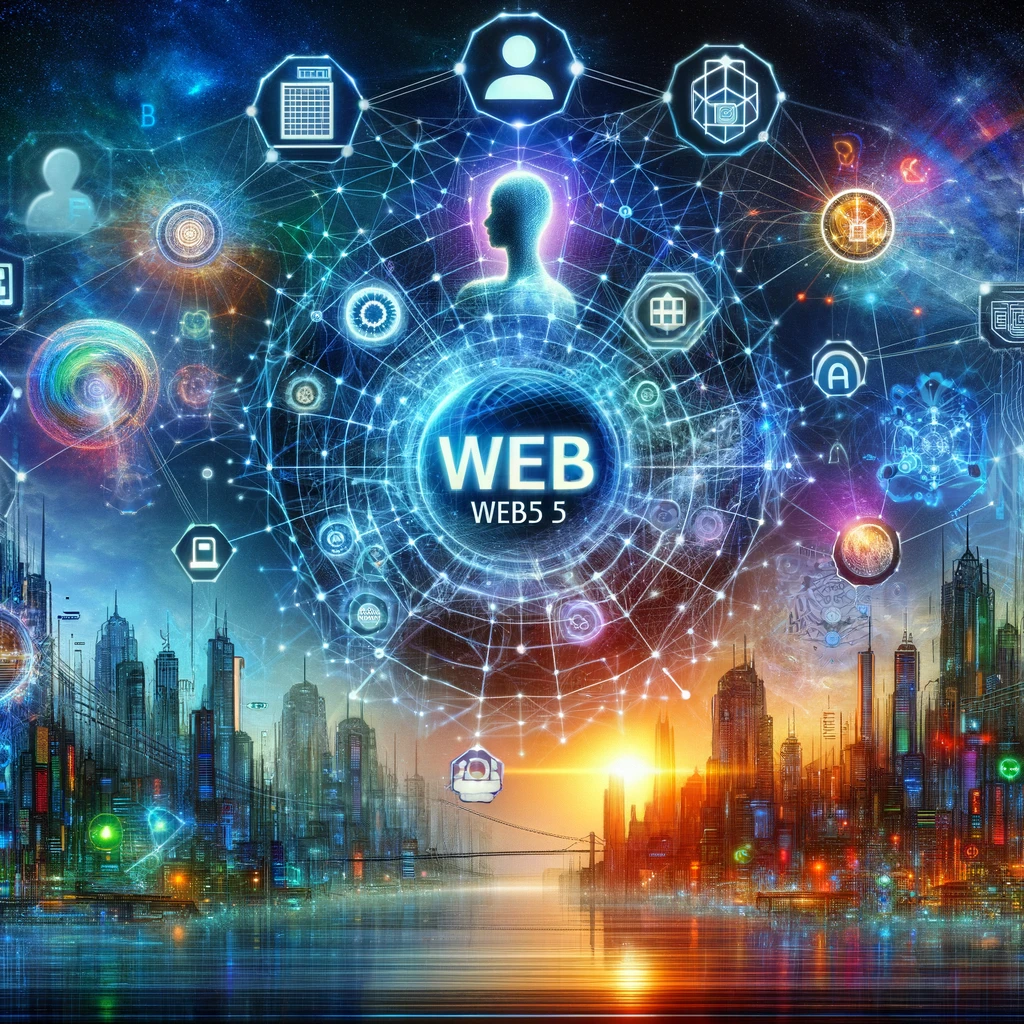Web5: The Next Revolution in Internet Freedom and Identity
 Okafor Peace Ngozi
Okafor Peace Ngozi
Are you ready for the next generation of the Internet? Web5 is the next-level decentralized web technology for reshaping the digital universe. Think of a world in which you own your online identity, in which your personal information is protected, and in which internet freedom takes precedence.
Web5 brings an exciting proposition: true ownership and control of your digital identity and data. But what does this mean in practical terms? In this new paradigm, Web5 empowers individuals to own their online identities without reliance on centralized entities. It's a shift from the current model where big tech companies hold significant sway over user data and privacy.
In this article, we will discuss the concept and features of Web5 and its ability to change how we relate to online life. However, what does Web5 entail, and what makes it different from Web3? We’ll reveal the major distinctions between these two Web5 technologies and demonstrate the exclusive benefits of Web5.
The Evolution of the Internet
The internet has moved from Web1 to Web 5, a phenomenal story of constant change that has redefined the digital space.
Web1, sometimes called “read-only” web, was the first phase during which the content was static and the user interaction was minimal. It was a digital domain of plain, static websites serving data without user-produced content or interaction.
However, as the web grew to Web2, or the “read-write” web, it became more dynamic and interactive. User engagement grew immensely through online platforms such as social media, e-commerce, and user-generated content. Nonetheless, interactivity came at a price-increased centralization, where a few large companies became central players that dictated large parts of the online experience and user data.
Web3, emphasizing “decentralization,” introduced concepts like blockchain, smart contracts, and cryptocurrencies. It sought to grant users more control over their data and online engagements and less dependence on central authorities. Yet, Web3 was more or less about the economic side of internet use centered on cryptocurrencies and DeFi apps.
Web5 is coming up, and the emphasis is shifting towards inclusive decentralization. Web5 seeks to integrate the Web3 principles and broaden the scope beyond finance. This involves identity, data ownership, and user autonomy. The newest version of the internet is on the verge of making a more harmonious online ecosystem with control redistribution toward individual users.
The Shift from Centralization to Decentralization
The evolution of the internet is a core theme in the shift from centralization to decentralization. In Web1 and Web2, centralization implied that the user’s data, content production, and digital engagement were largely in the hands of a few powerful players. These issues were brought about by the centralization and, subsequently, the concerns of privacy data security and monopoly of the digital space.
One of the key principles of Web3, and now Web5, is decentralization. This challenges the above model for control, where control is decentralized and distributed across a wider network. However, this shift is technical and philosophical, calling for a more democratic and equal online space.
The essence of Web5 decentralization is enabling individuals to control their digital identities and information without the drawbacks and risks of centralized networks. It outlines a world where users become more than just information consumers but shapers of the digital environments they govern.
Features of Web5
In this section, we delve into the essential characteristics of Web5. Let's explore these key features to understand how they collectively redefine our digital experiences and interactions.
Decentralized Identity
User-Controlled Identities: Unlike centralized platforms, users create and manage their identities.
Independence: Identities are not tied to any single platform.
Security: Utilizes cryptographic techniques for secure, verifiable identities.
Interoperability: Use the same identity across different platforms and services.
Data Ownership and Privacy
User Ownership: Users have complete control over their data.
Decentralized Storage: Data is stored in decentralized networks, not controlled by one entity.
Permissioned Access: Users set permissions for who can access their data.
Privacy-First Approach: Prioritizes user consent and privacy in data sharing.
Enhanced Security Measures
Blockchain-Based Security: Leverages blockchain technology for enhanced security.
Decentralized Consensus: Prevents single points of failure and data breaches.
Cryptographic Encryption: Ensures data integrity and confidentiality.
Transparent and Immutable Records: Makes data manipulation easily detectable.
Understanding the Differences between Web5 vs. Web3
The table below is a comparison of Web5 and Web3 focusing on their core philosophies, technological advancements, and impact on user experience:
Aspect | Web5 | Web3 |
Core Philosophies | ||
Decentralization | Extends beyond financial transactions to include identity and data ownership. | Primarily focused on decentralizing financial transactions and applications. |
User Autonomy | Prioritizes user control over identity and data, enhancing personal autonomy. | Focuses on removing intermediaries in financial dealings and applications. |
Data and Identity | Emphasizes decentralized identity and data ownership. | Less focus on identity and more on decentralized applications (DApps). |
Technological Advancements | ||
Identity Management | Introduces decentralized identity management systems. | Lacks a comprehensive approach to decentralized identity. |
Data Storage | Utilizes decentralized storage for user data, enhancing privacy and control. | Primarily uses blockchain for transactional data, with less emphasis on personal data storage. |
Interoperability | Aims for high interoperability across various internet services and applications. | Interoperability is mainly within the blockchain and DApp ecosystems. |
Impact on User Experience | ||
User Control | Provides users with more control over their digital presence and data. | Offers control of financial transactions and DApp usage. |
Privacy | Enhanced privacy through decentralized data ownership and control. | Privacy focus is mainly transactional and within DApps. |
Accessibility | Aims for a user-friendly approach to managing online identity and data. | Sometimes, it is complex due to the technical nature of blockchain and cryptocurrencies. |
Innovative Application of Web5
Web5 is no mere theory but an enabler for several utilities capable of transforming many industries within the business and educational environment.
Here's an overview of what can be built on Web5:
Decentralized Social Media Platforms: Picture a social media platform where you are in charge of your information without third-party supervision. Decentralized social platforms based on Web5 technology allow users to generate and control their content and networks rather than give these rights to central platform providers.
Personal Data Vaults: Through Web5, one would have personal data vaults within which the individual data is kept safe. This way, they can provide/withdraw access to this data anytime, thus maintaining privacy and controlling it.
Digital Identity Verification Systems: Using Web5, one can develop authentic and safe identity confirmation mechanisms. This type of system does not require revealing redundant personal data such as logging into web pages, proving one’s identity and age, or anything else.
Decentralized Marketplaces: Web5 envisions e-commerce in a new way by eliminating intermediaries, thereby reducing fee charges and increasing transparency for direct buyer-seller transactions.
Healthcare Data Management: Web5 technology in healthcare may help establish secure patients’ controlled medical records. This allows patients to decide who can access their information and enables more efficient healthcare provision.
Education and Credentialing: Web 5 creates a platform that ensures the storage and verification of academic records and certification certificates. This would eliminate the fear of cheating.
Content Monetization Platforms: For creators, Web5 provides an alternative means of generating direct revenue from their target audience without relying on conventional advertisement-driven systems with fewer incentives.
Secure Voting Systems: Web5 could provide a safe, open electoral process for either elections or organization decisions regarding legitimizing the voting procedure.
Final Thought
Web5 represents the next generation of decentralized web technology, poised to revolutionize internet freedom and redefine digital identity. It emerges as a groundbreaking development in the digital world. Its core philosophy revolves around giving users control over their digital identities and data, a significant shift from the centralized models of previous internet iterations.
Looking forward, the adoption of Web5 technology promises to shape the future of the Internet in several compelling ways. We can anticipate a more secure and privacy-conscious digital landscape, where users have greater control over their personal information and online interactions. The decentralization at the heart of Web5 also indicates a future less dominated by major tech companies, potentially leading to increased competition and innovation.
Therefore, as Web5 evolves, it will influence new regulatory frameworks and policies around digital rights and data protection. This would ensure the internet remains safe and open for all users.
References
Subscribe to my newsletter
Read articles from Okafor Peace Ngozi directly inside your inbox. Subscribe to the newsletter, and don't miss out.
Written by

Okafor Peace Ngozi
Okafor Peace Ngozi
My name is Okafor Peace, I am a Technical Writer from Nigeria and I love learning how to write more meaningful code & building web applications. I love Tech and I am interested in exploring the tech industry.